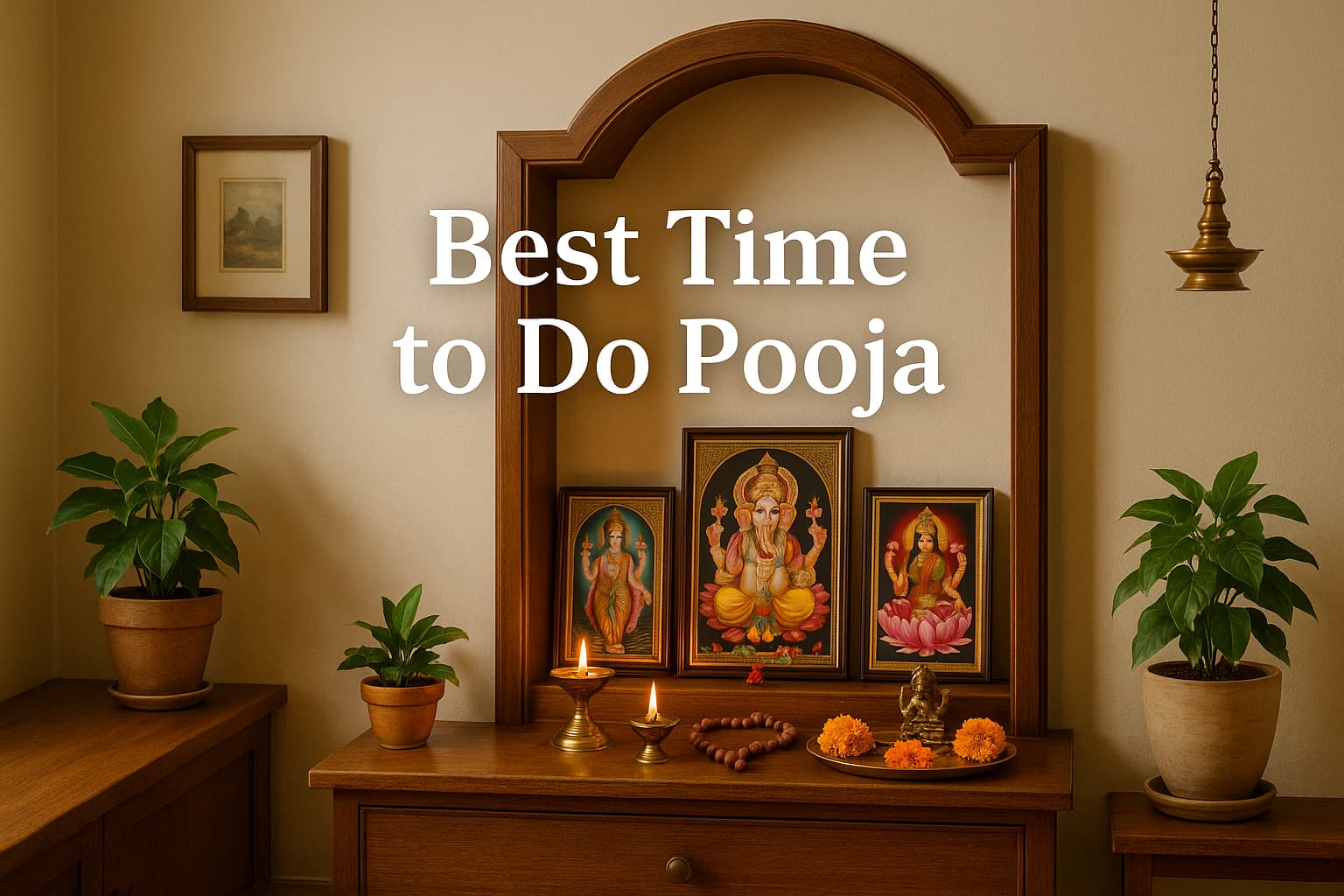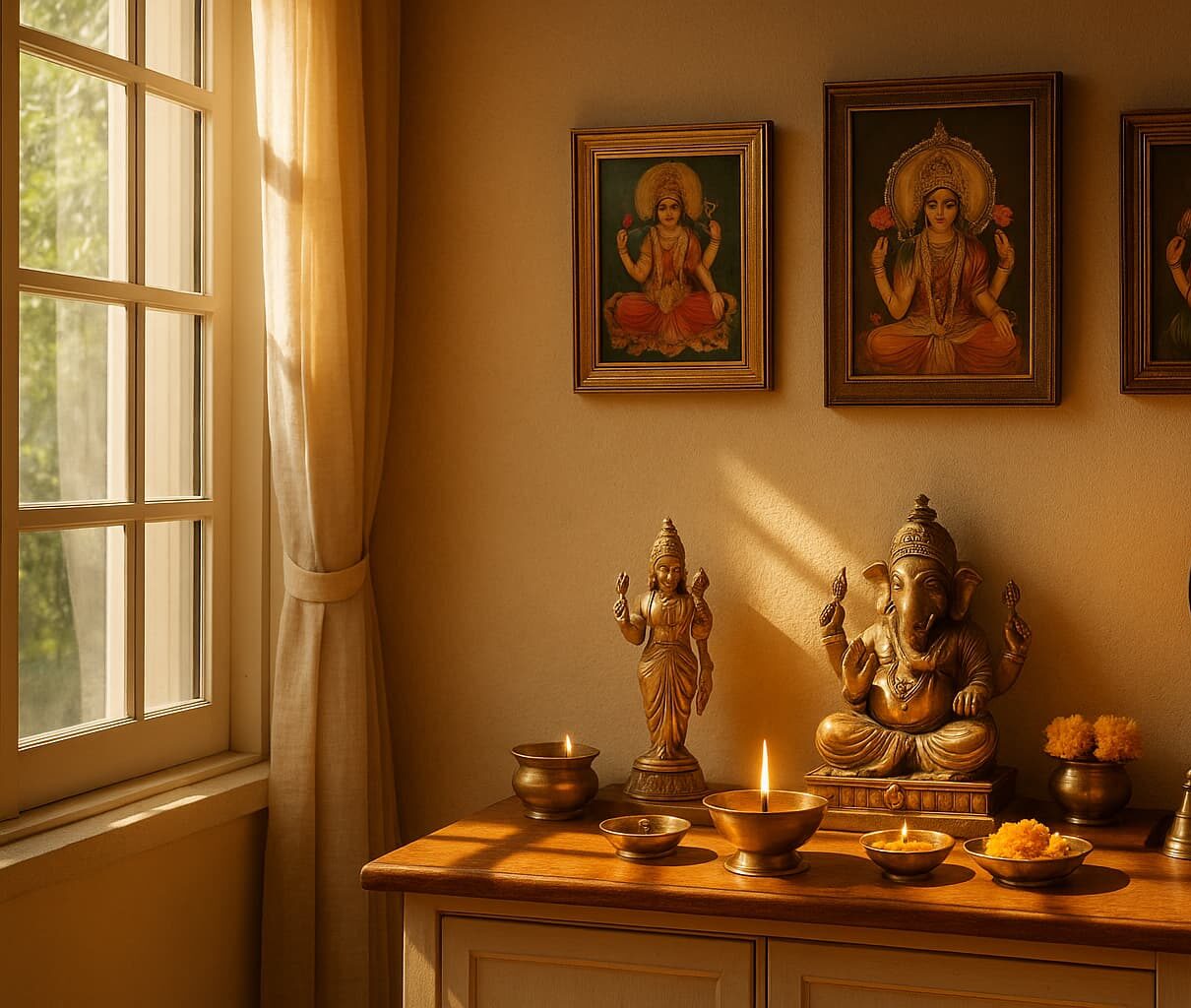Best time to do pooja at home is a question many Hindu families ask as part of their daily spiritual routine. Whether it’s a quick morning prayer or a full ritual, knowing when to perform pooja can enhance its spiritual effect. While customs vary across regions, there are certain times of the day that are traditionally believed to hold more positive energy. This article clearly explains the best time to do pooja at home today, why those timings are considered sacred, and how you can align your daily worship with traditional Hindu wisdom.
🌅 Why Timing Matters in Hindu Rituals (Bullet Style)
In Hindu traditions, time is viewed as energy, not just numbers on a clock. Certain hours carry different gunas (qualities) — sattvic (pure), rajasic (active), and tamasic (dull).
Performing pooja during sattvic hours is believed to improve focus, peace of mind, and divine connection.
According to the Manusmriti and Yajnavalkya Smriti, the period called Brahma Muhurta (around 1.5 hours before sunrise) is the most auspicious time for worship and meditation.
The Garuda Purana mentions that early morning pooja pleases deities and helps in gaining spiritual clarity.
Even the Bhagavad Gita (6.10) encourages early morning spiritual practice, suggesting the mind is calmest during these hours.
Whether you’re doing a simple diya lighting or chanting mantras, following these spiritually recommended times enhances the atmosphere and deepens your spiritual connection.
🗓️ Day-Wise Pooja Time & Deity Focus (Traditional Guide)
Traditionally, each day of the week is dedicated to a specific deity, and the timing can align with those spiritual energies.
| Day | Main Deity | Best Time | Symbolic Meaning & Offerings |
|---|---|---|---|
| Monday | Lord Shiva | 6:00–8:00 AM | Pray for calm and health. Offer water, bilva leaves, and chant “Om Namah Shivaya”. |
| Tuesday | Durga / Hanuman | Sunrise to 9:00 AM | Invoke strength and protection. Offer sindoor (Hanuman) or red flowers (Durga). |
| Wednesday | Ganesha / Vishnu | 7:00–9:00 AM | Seek wisdom and harmony. Offer durva grass (Ganesha) or tulsi (Vishnu). |
| Thursday | Guru / Vishnu | Brahma Muhurta or Morning | Pray for knowledge and blessings. Offer yellow flowers and chant Vishnu Sahasranama. |
| Friday | Lakshmi / Durga | Morning or Early Evening | Invite wealth and peace. Offer white or pink lotus and chant Kanakadhara Stotra. |
| Saturday | Shani / Hanuman | Sunrise or After Sunset | Pray for protection from negativity. Offer sesame oil, black cloth, or tulsi. |
| Sunday | Surya (Sun God) | 6:00–7:00 AM (Sunrise) | Seek energy and confidence. Offer water to the sun and chant “Aditya Hridayam”. |
🕰️ Daily Pooja Timings That Suit Most Homes (with Practical Tips)
1. Brahma Muhurta (Ideal Time for Early Risers)
🕓 Time: Approximately 4:00 AM to 6:00 AM
Considered the most spiritually powerful time of the day.
Ideal for meditation, mantra chanting, and setting a peaceful tone for the day.
According to tradition, the mind is calmest and most focused during this period.
🌿 Example: In villages of Karnataka’s Uttara Kannada, elders often rise before sunrise, light lamps near the Tulsi plant, and chant prayers facing the east — embracing nature and silence.
✅ Tip:
Even if you can’t do a full pooja, just sitting silently or lighting a diya during Brahma Muhurta creates a strong spiritual impact.
2. After Sunrise (Best for Daily Routine Pooja)
🕖 Time: 6:00 AM to 8:00 AM
Ideal for families with school, work, and home duties.
This time is suitable for offering fresh flowers, lighting incense, and chanting stotras like Suprabhatam or Lakshmi Ashtakam.
✅ Tip:
Keep a small thali ready the night before with items like agarbatti, diya, and flowers — so your morning pooja feels effortless even on busy days.
3. Evening Sandhya Time (Balance & Gratitude)
🌇 Time: Around sunset (5:30 PM to 6:30 PM)
Traditionally known as Sandhya Vandana time — a powerful period to wind down the day.
Ideal for lighting lamps, chanting Vishnu Sahasranama, Durga Kavach, or simply offering gratitude for the day.
✅ Tip:
Light a diya facing east or northeast direction. If you missed the morning pooja, use this time for a short peaceful moment of connection.
🧘♀️ What If You Miss the “Right Time”?
Not everyone has the flexibility to follow exact pooja timings — especially with today’s busy routines. Between office work, school responsibilities, or health limitations, it’s natural to miss the ideal hour. But here’s the comforting truth: in Hinduism, intention (bhava) is more powerful than the clock.
Even if you can’t do pooja during Brahma Muhurta or sunrise, you can still connect with the divine later in the day — including the afternoon.
A housewife in Hubballi once said, “I sometimes miss the morning pooja. So I light the diya in the evening, even if it’s late — I believe God understands.” That kind of heartfelt devotion carries its own strength.
🕛 What About Afternoon Pooja?

While afternoon (roughly 12:00 PM to 3:00 PM) is not traditionally emphasized for worship, it can still be used for:
Silent meditation or chanting
Offering food (naivedya) before lunch
Reading spiritual texts or mantras quietly
In temples, some midday rituals are conducted for deities like Vishnu, Lakshmi, and Surya. So if this is the only time available to you, use it with peace — even 5 minutes of quiet focus can elevate your spirit.
✅ Key Takeaways:
Sincerity > Schedule: A clean heart matters more than the hour.
Short prayers still count: Even 2 minutes of mantras or diya lighting can be powerful.
Find your personal rhythm: Set a time that fits your life — and stick to it.
Afternoon is okay: If that’s when you’re most at peace, use it mindfully.
In the end, the best time to do pooja at home today is when your heart is still, and your thoughts are with the divine.
🛑 Times to Avoid (As per Traditions)
While Hinduism encourages flexible devotion, certain times are traditionally considered spiritually less favorable for pooja. These periods are believed to carry tamasic (dull or distracting) energies, which may affect focus and purity during worship.
❌ Common Times to Avoid for Pooja:
🕑 Rahu Kaal:
A roughly 90-minute period that occurs daily but varies depending on sunrise. Traditionally avoided for starting anything auspicious, including pooja or new rituals.
👉 Tip: Use a Panchang app or calendar to find your local Rahu Kaal timings.🌑 Eclipse (Grahan) Periods:
Solar and lunar eclipses are generally considered inauspicious. During these times, most temples remain closed, and worship is paused.
👉 Exception: Some traditions allow silent chanting or meditation during an eclipse.😴 Sleepy, Distracted, or Angry State:
It is better to postpone pooja than perform it with a disturbed mind or laziness. Purity of thought and calmness are more important than ritual timing.🍽️ Immediately After Heavy Meals:
Avoid doing pooja when your body feels dull or heavy. It is better to pray with a light, clean state — both physically and mentally.🧼 Unclean Body or Surroundings:
According to tradition, one should not perform pooja before bathing or in untidy surroundings, as cleanliness is seen as part of spiritual preparation.
✅ Key Reminder:
You don’t need to be perfect — just respectful and sincere. These traditional guidelines help create a sacred space, but devotion is always accepted when offered with a pure heart.
Read more about how many times a temple bell should be rung and the spiritual meaning behind each strike in our detailed guide.
👉 How Many Times Should a Temple Bell Be Rung?
🙏 Do You Need to Follow These Timings Strictly?
Not at all. These timings are traditional suggestions, not strict rules. They’re meant to help you align your energy with spiritual rhythms, not to create pressure. Life is dynamic — and so is devotion.
Even if you miss the ideal timing, lighting a diya with a clean mind, offering a flower with love, or simply saying “thank you” to the divine is more powerful than a perfectly timed ritual done without sincerity.
🪔 Pooja is not about when — it’s about how you feel while doing it.
Tip: Create your own spiritual pocket in the day — even 5 quiet minutes can bring balance and peace.
The best time to do pooja at home today is the time when you can be mentally present, emotionally calm, and spiritually connected. Whether it’s morning, noon, or evening — your intention is what truly matters.
Hindu traditions provide us with a beautiful structure, but they also encourage us to adapt based on our lifestyle. In a fast-paced world, even the act of pausing to light a lamp or chanting a few mantras with awareness can turn your home into a temple of peace.
Start small, stay consistent, and let your pooja time become your personal moment of inner joy.
Learn why people hang lemon and chilies on vehicles and how this symbolic act connects with traditional beliefs in energy and protection.
👉 Why Lemon Chilies on Vehicles?
Discover the deeper significance of pooja in Hinduism, including its rituals, types, and purpose across different traditions.
👉 Puja – Hindu Worship (Wikipedia)


